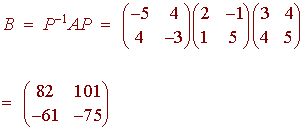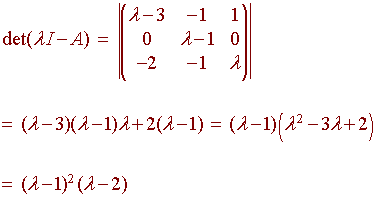Diagonalization
Similar Matrices
We have seen that the commutative property does not hold for matrices, so that if A is an n x n matrix, then
P-1AP
is not necessarily equal to A. For different nonsingular matrices P, the above expression will represent different matrices. However, all such matrices share some important properties as we shall soon see.
Let A and B be an n x n matrices, then A is similar to B if there is a nonsingular matrix P with
B = P-1AP
Example
Consider the matrices

Then

is similar to A.
Notice the three following facts
- A
is similar to A.
- If
A
is similar to B
then B
is similar to A.
- If A is similar to B and B is similar to C then A is similar to C.
We call a relationship with these three properties an equivalence relationship. We will prove the third property.
If A is similar to B and B is similar to C then there are matrices P and Q with
B = P-1AP and C = Q-1BQ
We need to find a matrix R with
C = R-1AR
We have
C = Q-1BQ = Q-1(P-1AP)Q =
(Q-1P-1)A(PQ) = (PQ)-1A(PQ) = R-1AR
There is a wonderful fact that we state below.
Theorem
If A and B are similar matrices, then they have the same eigenvalues.
Proof
It is enough to show that they have the same characteristic polynomials. We have
det(lI - B) = det(lI - P-1AP) = det(P-1lIP - P-1AP)
= det(P-1(lI - A)P) = det(lI - A)
Diagonalized Matrices
The easist kind of matrices to deal with are diagonal matrices. Determinants are simple, the eigenvalues are just the diagonal entries and the eigenvectors are just elements of the standard basis. Even the inverse is a piece of cake (if the matrix is nonsingular). Although most matrices are not diagonal, many are diagonalizable, that is they are similar to a diagonal matrix.
A matrix A is diagonalizable if A is similar to a diagonal matrix D.
D = P-1AP
The
following theorem tells us when a matrix is diagonalizable and if it is how to
find its similar diagonal matrix D.
Theorem
Let A be an n x n matrix. Then A is diagonalizable if and only if A has n linearly independent eigenvectors. If so, then
D = P-1AP
If {v1, ... , vn} are the eigenvectors of A and {l1, ... , ln} are the corresponding eigenvalues, then
vj the jth column of P
and
[D]jj = lj
Example
In the last discussion, we saw that the matrix

has -1 and 4 as eigenvalues with associated eigenvectors

Hence

D = P-1AP
Proof of the Theorem
If
D = P-1AP
for some diagonal matrix D and nonsingular matrix P, then
AP = PD
Let vi be the jth column of P and [D]jj = lj. Then the jth column of AP is Avi and the jth column of PD is livj. Hence
Avj = livj
so that vj is an eigenvector of A with corresponding eigenvalue lj. Since P has its columns as eigenvectors, and P is nonsingular, rank(P) = n, and the columns of P (the eigenvalues of A) are linearly independent.
Next suppose that the eigenvalues of A are linearly independent. Then form D and P as above. Then since
Avj = livj
The jth column of AP equals the jth column of PD, hence AP = PD. Since the columns of P are linearly independent, P is nonsingular so that
D = P-1AP
Theorem
Let A be an n x n matrix with n real and distinct eigenvalues. Then A is diagonalizable.
Proof
Let
{l1, ... , lk} and {v1, ... , vk}
with
rank(Span({v1, ... , vk})) = k - 1
be the eigenvalues and eigenvectors of A. We need to show that none of the vectors can be written as a linear combination of the rest. Without loss of generality, we need show that the first can not be written as a linear combination of the rest. If
v1 = c2v2 + ... + cnvk (1)
We can multiply both sides of the equation by A to get
l1v1 = Ac2v2 + ... + Acnvk = c2l2v2 + ... + cnlnvk (2)
Multiply (1) by l1 and subtract it from (2) to get
c2(l2 - l1)v2 + ... + cn(ln - l1)vn = 0
Since the l's are distinct, the ci's must all be zero, which is a contradiction (otherwise the rank would be less than k - 1). Hence
rankSpan({v1, ... , vk}) = k
for any k. In particular, let k = n, and the result follows.
Note that the converse certainly does not hold. For example, the identity matrix I has 1 as all of its eigenvalues, but it is diagonalizable (it is diagonal).
Steps to Diagonalize a Matrix
- Find the eigenvalues by finding the roots of the
characteristic polynomial.
- Find the eigenvectors by finding the null space of
A - liI.
- If the number of linearly independent vectors is
n, then let P
be the matrix whose columns are eigenvectors and let D
be the diagonal matrix with [D]jj
= lj
Example
Diagonalize the matrix

Solution
We find the characteristic polynomial

The roots are 1 (with multiplicity 2) and 2 (with multiplicity 1).
Now we find the eigenspaces associated with the eigenvalues. We have

A basis for the null space is

Next we find a basis for the eigenspace associated with the eigenvalue 2. We have

A basis for this null space is

Now put this all together to get

Back to the Linear Algebra Home Page
Back to the Math Department Home Page
e-mail Questions and Suggestions